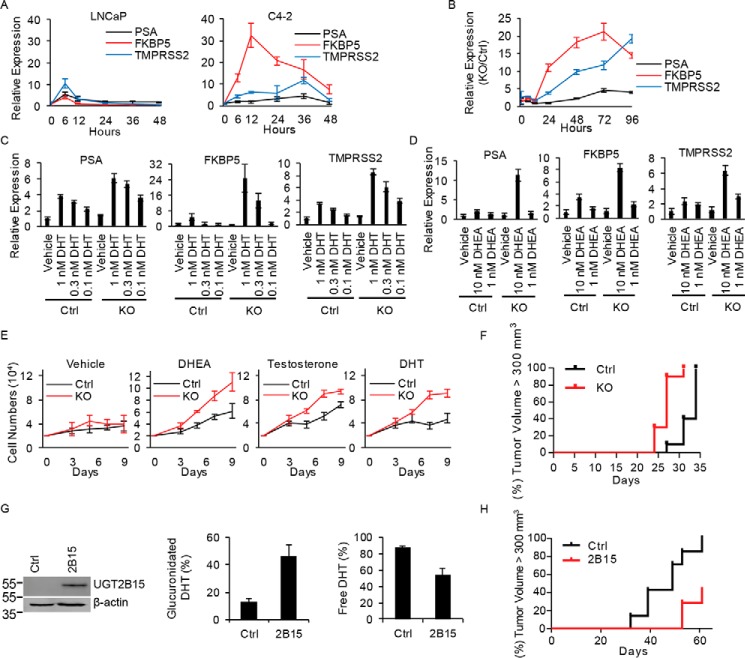Figure 4.
Genetic loss of UGT2B15 and UGT2B17 promotes sustained androgen-responsive gene expression, cell proliferation, and promotes CRPC growth. A, castration-resistant C4-2 cells have persistent induction of androgen-responsive gene expression with DHT stimulation. Cells were treated with CSS media for 72 h, treated with DHT (10 nm) for the designated incubation times, and expression of PSA, FKBP5, and TMPRSS2 was assessed in triplicate by qPCR and normalized to RPLPO. Compared with WT LNCaP (Ctrl), combined loss of UGT2B15 and UGT2B17 (LNCaP KO) recapitulates sustained androgen-responsive gene expression with (B) DHT (10 nm) treatment over time and in (C) DHT and (D) DHEA concentration-dependent manners. Expression of PSA, FKBP5, and TMPRSS2 was assessed in triplicate by qPCR and normalized to RPLPO and vehicle treatment. In B, expression in KO cells is also normalized to Ctrl cells. Error bars represent the S.D. E, loss of UGT2B15 and UGT2B17 augments androgen-responsive cell proliferation. Cells were treated with vehicle, DHEA (100 nm), testosterone (100 nm), and DHT (10 nm), in triplicate, and counted after treatment for the indicated number of days. F, castration-resistant growth in vivo is hastened in KO (n = 10 mice) compared with Ctrl (n = 10) tumors (p = 0.0002). Three days after subcutaneously injecting cells into NSG mice, mice were surgically orchiectomized and implanted with DHEA pellets to mimic human adrenal physiology. The significance of the difference in progression-free survival between groups, as assessed by tumor volume >300 mm3, was assessed by log rank test. G, UGT2B15 expression in C4-2 cells reinstates enzymatic DHT glucuronidation. C4-2 cells were stably transfected with control vector (Ctrl) or UGT2B15 (2B15) and expression was assessed by immunoblot. Next, cells were treated with [3H]DHT (10 nm) for 6 h and free and glucuronidated DHT was assessed by HPLC in triplicate. Error bars represent the S.D. H, restoration of DHT glucuronidation activity suppresses castration-resistant xenograft growth. Ctrl and 2B15 cells (n = 7 mice per group) were subcutaneously injected in orchiectomized mice, progression-free survival was assessed as tumor volume >300 mm3, and the significance of the difference between groups was compared with log rank test; p = 0.0035.

